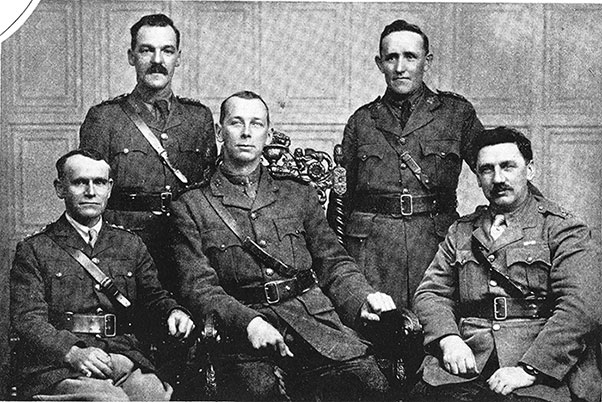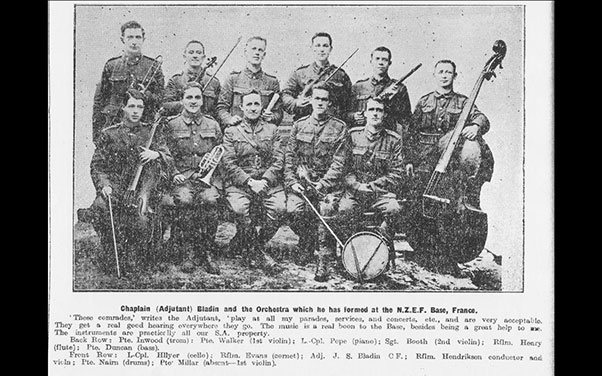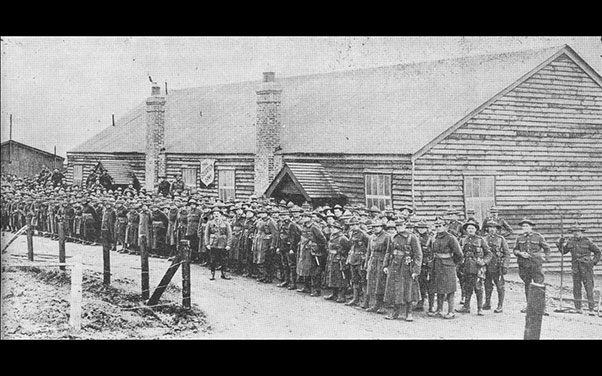You are here
New Zealand Salvation Army Padres in WWI
Do you know Adjutant Greene? Well, the boys in Egypt say, “Ask the Salvation Army if they have any more Greenes. If they have, let us have them!”
– Returning New Zealand soldier.[1]
Our Padre is one of the finest men that ever lived, and if anybody ought to be rewarded with the VC it ought to be him.
– New Zealand soldier writing home about Padre Walls[2]
What lay behind such tributes to New Zealand Salvation Army military chaplains?
Four officers assigned to the Territorial Forces in New Zealand in 1913 were the first Salvationists in the world to be appointed to such a role. The 1911 New Zealand Defence Act, along with introducing compulsory military training, established a Chaplains Department. At first the Church of England, Methodist, Presbyterian and Roman Catholic churches and later the Salvation Army, Baptist, Associated Church of Christ and Congregational denominations were invited to contribute chaplains.[3]
The Territorial Commander, Commissioner W. J. Richards, selected Brigadier William Hoare, Staff-Captain David Gunn, Adjutant Andrew Gray and Adjutant Haywood, who were gazetted as Territorial Chaplains late in 1913.[4] These were part-time appointments, and none of these initial appointees actually saw overseas service in the war. Eight Salvationists, out of the 130 New Zealand Chaplains, served abroad over the following four years: John S. Bladin, Edward L. Garner, Alfred Greene, Samuel S. Green, Charles Walls, Walter S. Winton, Donald Macauley and Herbert Colledge. The last two actually arrived in Europe after the armistice.
Before embarkation, the work involved getting to know the men – mostly young, excited and anxious. Captain Charles Walls, describing his Trentham camp routine in 1915, wrote of clerical work, arranging facilities, holding church parades and joining in with the men at games, as well as getting alongside Christians “to encourage them by influence to continue to do right and uphold the standard of Christianity.”[5

Padre Walter Winton, (back left) with other Salvation Army Chaplains; Bladin (back right), Walls (centre) Garner (front left) and Greene (front right).
One un-named Salvationist padre evidently “so endeared himself to the men … through his unselfishness and paternal interest in them, that attendance at his daily services grew from 30 to 400 or 500.” Hearing that he was unlikely to accompany them overseas because there were too few attested Salvationists in the battalion, some four hundred men approached their platoon commanders to explain that they’d made a mistake as to their denomination and that they were actually Salvationists.[6]
The first to go overseas was Adjutant Alfred Greene who sailed with the New Zealand Expeditionary Force in September 1914, only a month after the declaration of war. Lest it be thought that chaplains had only to conduct the occasional church parade and offer a listening ear to servicemen seeking the consolations of religion, Greene and his comrades were soon busy with welfare work in addition.
Greene was based firstly in Egypt, where he was appointed as Officer in Charge of New Zealand Gifts to troops – which meant over-all responsibility for welfare. When the men went on to Gallipoli in April 1915 he was ordered to remain in Egypt and was soon meeting shiploads of casualties returning from the front. His work was described in 1916:
He has a commission to visit all the New Zealand sick and wounded in [Egypt] … there are 12 hospitals and 6 convalescent homes. He is a sort of everyday Father Christmas, and has always something on hand in the way of comforts for the sick and wounded… boarding of all hospital ships coming into harbour... [He has] a permit to visit all the fronts where New Zealanders are fighting, and while there, do his best for the physical, mental and moral welfare of the men. Red Cross goods also come under Chaplain Greene’s control… at Christmas-time, he had no less than 15 truck-loads of goods… to distribute to the New Zealand men.
I was introduced by the Captain to General ------. The former left the room for a minute or two… and the General turning to me, remarked: “That is one of the best fellows we have. He gets a thing done while others are thinking about it.”[7]
Securing a large shed, Greene equipped it with a piano, lighting and heating for the winter months, setting up an “Institute” like those in the training camps at home. In a church borrowed from the French Evangelical Church, he took services for any Protestant troops (the Catholics had their own chaplain).[8]
When a New Zealander was reported as being mugged in a Cairo alley, Green and another Rifle Brigade Officer found a crowd attacking the prostrate man. “The Padre rushed in, grabbed the man, slung him over his broad shoulders, and ran with him to the station. ‘I think,’ writes the Taranaki Herald’s informant, ‘that only a Salvation Army Padre would do such a thing as that.”[9]
When the infantry transferred to the European front in 1916, Greene ended up at Military Headquarters in England, where he remained for the duration. There he over-saw the distribution of gifts from home for the New Zealand troops (his nick-name, “Buckshee Greene”, stuck to him ever after), visited the sick and wounded in 160 hospitals … recording and marking of all New Zealand soldiers’ graves in Britain. In 1916 he was awarded the Military Cross and in 1918 his wife was able to join him in his work. After the war, they remained in Britain to help with the repatriation of troops and did not return home until December 1919, making Greene’s the longest tour of duty of any Salvation Army chaplain.[10]
Because of Greene’s success General Richardson, in charge of New Zealand military administration in England, sent home for more Salvationists. The Salvation Army ended up with a larger number of chaplains overseas than might have been justified by its share of the New Zealand population. (With less than half a per cent of the forces being attested Salvationists, the Army provided 6% of New Zealand chaplains overseas.[11]) Of those who went, only Walls spent extensive time in the front line, but it was the Chaplains’ base camp activities which consolidated their reputation.[12] Other New Zealand officers, Captain and Mrs McPherson and Captain and Mrs Elston, were therefore sent over as additional welfare workers with the troops in 1917.[13]
Walls and Garner were the next to leave after Greene, with the 9th Reinforcements bound for Egypt early in 1916. Garner assisted Greene in Cairo and was then posted to Hornchurch Convalescent Hospital in England and finally to the Torquay Depot. This was a camp for men awaiting repatriation: 1,500 permanently unfit men in 15 large houses scattered through the town. He had somehow to employ the men and to entertain them, both necessary for maintaining discipline. He arranged that volunteers could be sent out of camp for light work for additional pay and reported in 1918 that 400 men had so far taken up this opportunity. For entertainment he laid on boating, motor drives, garden parties and fetes, and provided equipment for bowls, cricket and tennis – as well church parades.[14] Garner spent February to October 1918 at a Reinforcement Camp at Abeele in France.[15] After studying the British Demobilisation Scheme, he returned to New Zealand after the armistice to report on this to Sir James Allen, the Minister of Defence.
From Egypt, Walls wrote to The War Cry about the welfare of New Zealand Salvationists – a report published June 1916 named 25 young men, whose parents were no doubt delighted to hear of them.[16] As Chaplain with the 2nd Wellington Brigade, described as “the tall chap that does things”, Walls went with them to France[17]. After working at Etaples Base Camp Walls went up to the trenches in mid-1917 and remained there until late 1918. A soldier wrote of him:
I have seen Padre Walls in his Institute and moving about among the men. I have watched him with his burial party carrying on under heavy fire, seen him catering to the comfort of the men in the trenches like a camel laden with good things. I was one of the little group which gathered under the shadow of a big gun just before Messines, while he put up a prayer for us, and I have seen him at it late into the night in connexion with grave particulars and fixing up the private belongings of men buried throughout the day.[18]
Walls himself described how when with a burial party along the Messines road, he turned over a dead body and found to his horror it was Will Bailey, a Wellington City bandsman.[19] Colonel J. McInnes related how when at the front “in a hot corner”, “a Roman Catholic priest was administering the last rites to some badly wounded soldiers when he was killed by a shell. [Walls] took the priest’s place, and from the dead man’s book read the service to the dying soldiers.”[20] McInnes may have been mistaken on one point; Father McMenamin and Walls were engaged in burying dead soldiers at the time.[21]
Another soldier wrote:
All the time the boys are in the line he is along with them; gets the daily paper into the front-line trenches every day – chocolates, socks and everything the boys want are given out by him every day, and he cares not for shells, gas, or any of Fritz’s buckshees, and I can tell you the boys reckon he’s the bravest and whitest man in the outfit. …[22]
Given an opportunity to go home in 1918, Walls refused. According to Garner, he said, “I’d go back tomorrow, only what about my boys. I’ll not vacate my position until my successor is here to take my place…”[23] However, he was evacuated after being severely injured when a bolting mule dragged a heavy cart across the dug-out in which he was sleeping.[24] He was also awarded the Military Cross for his services.
Walls was followed at Etaples by Adjutant John Bladin, a charismatic personality who earned the nickname “the singing Padre” – to augment his concertina, he recruited a small orchestra from amongst the troops. When Bladin replaced Walls in the front line not long before the armistice, Ensign Samuel S. Green, his successor at Etaples, worked with him for a week’s handover and paid tribute to him in the War Cry:
The work in which Captain Bladin has most excelled is his hospital visitation. Scattered round this camp at anything from one to six miles are something like twenty hospitals – anything up to fifty large wards in each… miles of walking and hours of hard work. This work has been greatly appreciated by the men. With his bag full of gifts (for he always took something to everyone) and his smiling face, he was an ever welcome visitor…[25]

Chaplain Walter Winton went to Egypt with the 19th/20th Reinforcement Mounted Rifles and on to England in early 1917, joining the 3rd New Zealand General Hospital at Codford. This included, a two miles’ walk away, a VD “detention camp” surrounded by a high barbed wire fence, with 30-50 admissions per week. Winton made himself so valuable that the Camp C.O. later refused to release him for posting to France. 6,000 men frequented his Institute hut weekly, with usually about 750 at Church Parade on Sunday – 300 had to be turned away one night.[26]
Winton helped men with letter-writing, distributed gifts, officiated at funerals, raised funds to supply pool tables, games and piano, and ran concerts. He obtained permission to plant a rose on each New Zealand soldier’s grave, and sent blooms and photos to the families at home. The troops nick-named him the “Old Digger”, and he was awarded the MBE (Military Division) in 1919. Remaining in Britain to help with soldiers’ repatriation, he did not get home until March 1920.[27]

Winton and troops at Codford
Throughout the war other Salvation Army officers; Hoare, Gunn, Gray, Haywood, Bear, Hawkins, Carter, Jackson, Burton and Dixon, served as chaplains in New Zealand, mainly at Trentham, Featherston and Tauherenikau training camps. Along with welfare workers, they did great work for the troops and raised the Salvation Army’s reputation to a new level.
The increase in the Self-Denial appeal total (quite separate from the large sums raised specifically for the Army’s war work) from £17,000 in 1913 to £50,000 in 1919 is some indication. A Masterton soldier’s letter home from Egypt sums it up: “In pre-war days we looked upon the Salvation Army with a certain amount of amusement; today we know its value at the front… The Salvation Army is out on its own.”[28]
[1] The War Cry, 25 September 1915, 3.
[2] Quoted by C.R. Bradwell, Fight the Good Fight (Wellington: Reed, 1982) 101-2.
[3] Mary Alison Tagg, “The Jesus Nut: A Study of New Zealand Military Chaplaincy”, PhD thesis, Auckland University, 2000, 23-24.
[4] The War Cry, 22 November 1915, 5.
[5] The War Cry, 2 October 1915, 3.
[6] Feilding Star, 30 December 1915, 2.
[7] Major B. Orames in The War Cry, 4 March 1916, 3.
[8] The War Cry, 25 March 1916, 7.
[9] Dominion, 5 February 1916, 12.
[10] Peter Bradley, “Men of All Creeds Swear by Him”. Hallelujah! Autumn 2008, 19-20.
[11] Press, 15 September 1917, 8. The 1911 census gave .96% of the population as Salvationist, and up to the 25th Reinforcement, in April 1917, .38% of soldiers attested as Salvationists.
[12] C.R. Bradwell, “Salvation Army Chaplaincy, a historical perspective”. Paper given at Armed Forces Chaplains’ Conference, Wellington, 22-24 April 1991, 7-8.
[13] The War Cry, 6 January 1917, 5.
[14] The War Cry, 27 April 1918, 7.
[15] “Report on The Salvation Army’s Work in Connection with the Great War 1914-18”, 6.
[16] The War Cry, 17 June 1917, 5.
[17] Evening Post, 27 August 1917, 2.
[18] The War Cry, 3 May 1919, 1.
19 Evening Post, 5 September 1917, 6. According to Archived Military Personnel records, 26371 Willie Bailey died of wounds on 7.7.17 and was buried by Chaplain H.C. Clark. Walls explained in a letter home (War Cry 1 September 1917, 6) that his burying of Bailey was interrupted by heavy shell fire and he had to retreat. The task was evidently completed later by Chaplain Clark during a lull in the shelling.
[20] Colonist, 4 October 1917, 4.
[21] The priest was Father James Joseph McMenamin, formerly parish priest at Petone, who was shot and killed at Messines in June 1917. http://www.teara.govt.nz/en/photograph/29292/funeral-of-catholic-chaplain
[22] Evening Post, 5 September 1917, 6.
[23] The War Cry, 9 November 1918, 7.
[24] Letter from Greene, The War Cry, 1 February 1919.
[25] The War Cry, 20 July 1918, 3.
[26] The War Cry, 25 May 1918, 1.
[27] Phil Lascelle, “Walter Sim Winton,” The Volunteers, Vol 30 No 1, 5-26, in Winton’s personnel file, Salvation Army Archives, Trentham.
[28] Wairarapa Daily Times, 21 February 1916, 4.